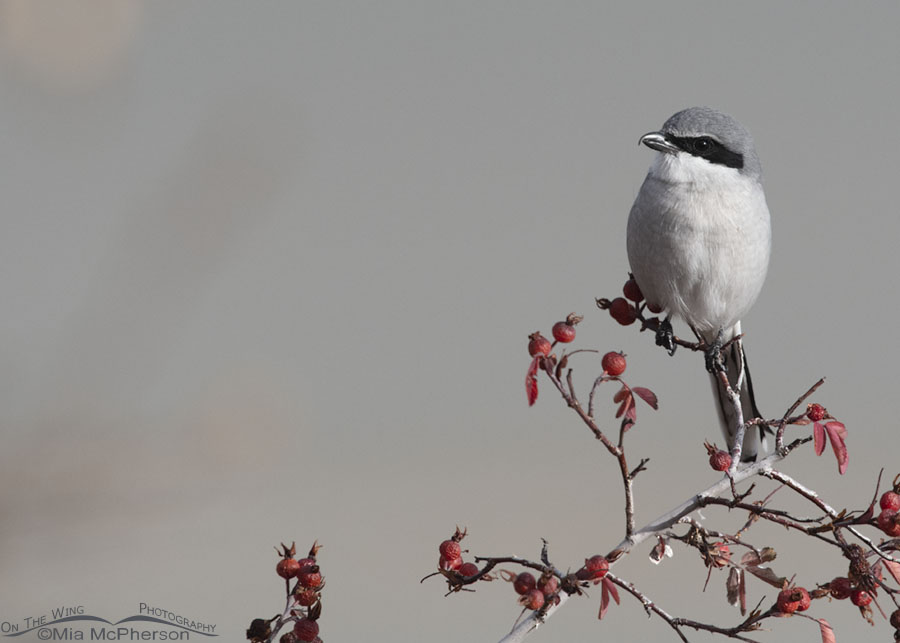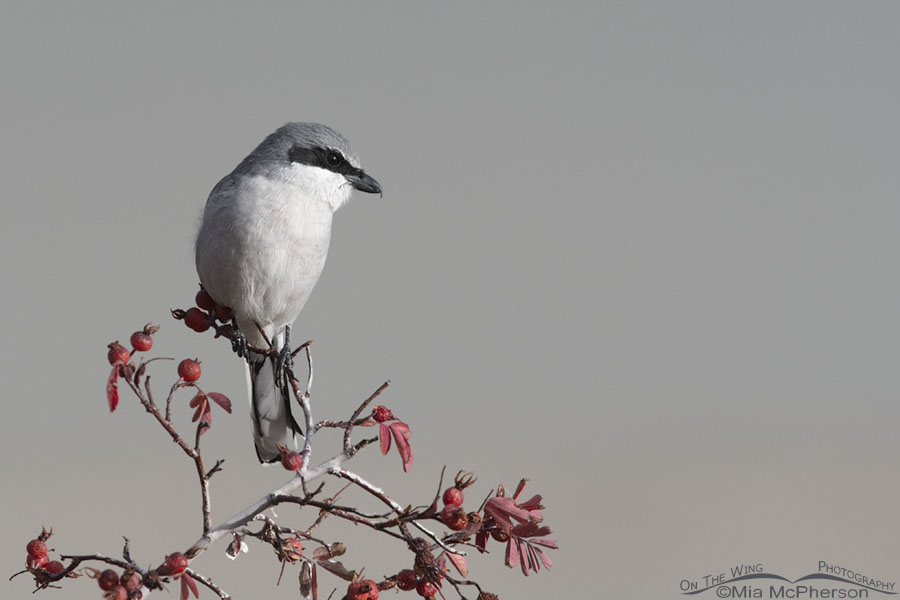It’s a thorny issue…
 Adult Loggerhead Shrike perched on a wild rose bush – Nikon D500, f7.1, 1/3200, ISO 800, Nikkor 500mm VR with 1.4x TC, natural light
Adult Loggerhead Shrike perched on a wild rose bush – Nikon D500, f7.1, 1/3200, ISO 800, Nikkor 500mm VR with 1.4x TC, natural light
When I found and photographed this adult Loggerhead Shrike two days ago I was happy with the pose, the light, and the simplicity of the background. The autumn colored leaves and red rose hips contrasted nicely with the blacks, whites, and grays of the plumage of the shrike and I liked the simplicity of the images I took.
I don’t see these shrikes as often as I used to so whenever I find them I am thrilled to have them in my viewfinder. Loggerhead Shrikes aren’t flashy birds but they are powerful little wanna be raptors that have earned my respect over the years.
Later when I returned home and looked at the photos I took of this Loggerhead Shrike I kept looking at the background of the images. The background is the out of focus playa of the Great Salt Lake. The extremely dry mud flats of the dying Great Salt Lake.
Had I taken these Loggerhead Shrike photos four to five years ago the background wouldn’t have been dry lake bed. It would have shown water. Precious, life-giving water. The shoreline has receded and now it is probably a half mile or more away from where it would have been and each year it moves farther away.
 Loggerhead Shrike perched in front of the dry playa of the Great Salt Lake – Nikon D500, f7.1, 1/2500, ISO 800, Nikkor 500mm VR with 1.4x TC, natural light
Loggerhead Shrike perched in front of the dry playa of the Great Salt Lake – Nikon D500, f7.1, 1/2500, ISO 800, Nikkor 500mm VR with 1.4x TC, natural light
I appreciate the photos I took of this handsome Loggerhead Shrike even more now than I used to because I believe they are already being affected by climate change here in northern Utah. Where I used to see a dozen or more of these shrikes I consider myself lucky to see one now and frankly that is terribly sad.
Sadder yet is watching the Great Salt Lake disappear before my eyes because it provides critical habitat in and around its shores for many hundreds of thousands of birds throughout the year, it brings money into the state from tourism, plus this inland sea helps put lake effect snow on the mountains for winter sports and more importantly, the water we need to sustain life in along the Wasatch front.
We could save this lake but that would mean that our government leaders in Utah would have to pull their heads out of their collective butts and I don’t believe they will do that. Not as long as they put business and industry before the citizens they were elected to represent. Not as long as they put party before people or their personal financial portfolios before the health of Utahns.
Without the lake and without a healthy environment future generations of Utahns will have to face the catastrophic consequences of their inaction. Climate change and water issues are already affecting us. The Great Salt Lake is in danger of becoming a toxic dustbin and that… that is a thorny issue.
There is always a story behind my photos. This morning the story is that I wonder if I will ever be able to look at these Loggerhead Shrike images without thinking about the dying lake.
Mia
Click here to see more of my Loggerhead Shrike photos plus facts and information about this species.


Wonderful and powerful narrative. For me these gentle and exquisite Shrike images underscore the ecological apocalypse of our time. Politicians, the self-serving elite in our society, have had decades to address the problem and have refused the call. I’m reminded of Buckminster Fuller’s concept of Spaceship Earth from nearly 60 years ago,,,
Per Wikipedia: “At a presentation to a group of architects in 1964, Buckminster Fuller challenged his audience to think of the Earth as a spaceship flying through the universe. With that image in mind, he asked them all to recognize that the resources on our ship are limited and that once they’re depleted, there’s nowhere else to go to get more. This was not said to depress his audience; instead, it was said to make them consider how we use our resources. It reminded them that we are all on the same ship and that whatever anyone does anywhere on the ship affects everyone else. Finally, it demonstrated how interconnected all of the systems in our world are and how balancing and optimizing them can benefit us.”
Little Greta gets it…
Great post Mia. Thanks.
Mia, The first image is gorgeous..beautifully composed. These Shrikes are harder to find everywhere. Thank you for reminding us what we are missing!
Water is an issue everywhere these days and it is only going to get worse ..too much or too little, floods, droughts, rising sea levels, melting ice etc. Nothing can live without it, yet politicians do not seem to care.
Human kind seems racing toward extinction…animals(including us) , air, water, soil, all on the “brink” of destruction/exrinction…we are far too shortsighted, geedy, ignorant and stupid to survive….it seems so obvious and inevitable….
Agitate, brave birders!
Sorry but “sad” is when butterfly goes bye-bye fly-away.
Reckless exploitation of a key bioregion is insane destruction, forevermore and unredeemable.
Jon,
Believe me, I would love use more, shall we say, “colorful” language instead of saying sad but I know that kids K-12 use my site as a reference at times so I try to keep things a little softer toned here for the most part. I’m about to take the kid-gloves off though. No pun intended.
Well understood. The remark was a “huddle-up!” call to your audience . . . there’s no time remaining
for a minute spent on sadness during the endgame of this accelerating tragedy. Act.
Brine shrimp industry on the Great Salt Lake $67 million a year income. It is hard to find a true number on the bird count. When I look through numbers of birds in reports it seems to be from 4 to 10 million birds migrate through and use the lake and it’s wetlands, the most recurring figure is 7 million, between 3 to 5 million eared grebes alone use the Great Salt Lake to fatten up on brine shrimp and flies for migration and breeding. Again a difference in numbers in reports, between 257 to 330 different species use the wetlands and lake. Add the standard food chain when you have less somewhere in the chain there will be less everywhere including shrikes, falcons, hawks, owls and eagles. As much as I dislike hunting, the hunters have clout in this state, maybe it is time to rile them up and get them more involved. Less water, less wetlands less ducks to hunt. I definitely know the duck numbers are down for hunting the last few years.
I mourn, with and for you. And the world. ANGRILY mourn.
This post breaks my heart, Mia. For the first time in 3 years I flew in and out of SLC last month. From my window seats I struggled to find the actual shoreline on the rapidly receding lake. I think of all of my joyful times shooting at Antelope & Stansbury Islands, the edges of the Saltflats and other areas around the (formerly) Great Salt Lake. Sadly, there is no magic wand we can wave to restore this unique and critically important habitat. But your words and exceptional photos help to call attention to this grave situation. Please consider printing and mailing your posts to elected officials, civic leaders – and the media. Perhaps ongoing, well-illustrated reminders will help more people feel the urgency needed to slow the demise or restore this special lake.